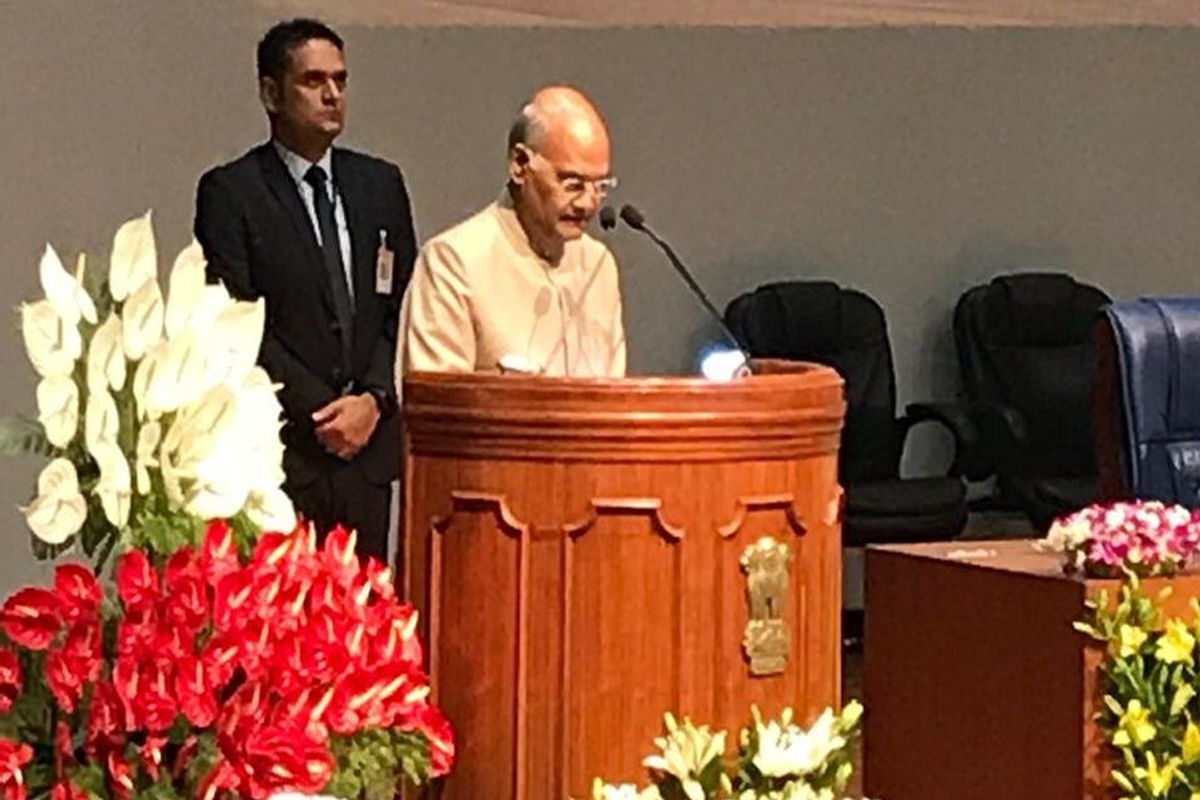Sonu Nigam performs at Rashtrapati Bhavan Diwas despite back pain
Sonu Nigam dazzles at Rashtrapati Bhavan Diwas, performing at the newly inaugurated Open Air Theatre, despite a recent painful back spasm.
The Additional Office Complex of the Supreme Court with a futuristic vision was planned on land measuring 12.19 acres abutting Pragati Maidan, according to a press statement.

President Ramnath Kovind in the inaugural ceremony (Photo: Twitter/@airnewsalaerts)
The Supreme Court on Wednesday gets a new administrative block, inaugurated by the President of India, Ramnath Kovind.
Chief Justice of India Ranjan Gogoi, Law Minister Ravi Shankar Prasad, Attorney General KK Venugopal, other Supreme Court judges, SCBA President Rakesh Khanna and Senior members of the Bar were present on the occasion.
Advertisement
“The Additional Office Complex of the Supreme Court with a futuristic vision was planned on land measuring 12.19 acres abutting Pragati Maidan,” a press statement said. It was planned to cope with the space constraints of the apex court.
Advertisement
During the event, the Supreme Court judge Justice SA Bobde handed over to the President a copy of Supreme Court judgments translated into regional languages. The President appreciated the launch of the software program translating the decisions into vernacular languages.
I appreciate the Supreme Court’s openmindedness in developing and deploying software that translates judgment texts into different languages. I am certain that with time and experience, the software program will only improve and incorporate many more languages #PresidentKovind
— President of India (@rashtrapatibhvn) July 17, 2019
The foundation stone of the building was laid on September 27, 2012. The building is a state-of-the-art, environment-friendly, centrally air-conditioned office complex with all modern facilities.
The curvature of the building is in the European style with pillars that rise from the ground level and the colour scheme and sandstone external cladding depicts an attempt to retain the original marvel of the Supreme Court.
Designed to maximize the use of available sunlight, air and water, the new complex will generate solar power of 1,400 KW which will be integrated into the main grid.
The project has been designed as a GRIHA (Green Rating for Integrated Habitat Assessment) -compliant energy-efficient building complex.
The new building will have five functional blocks and one service block, which are four to nine storeys high.
The additional building complex will have a three-level basement with car parking capacity for about 1,800 car units. The basements are connected to the old complex of the apex court by three all-weather underground passages.
It has been built by the Central Public Works Department (CPWD), with a total built-up area of 1,80,700 square meters and has imbibed technology-intensive features, a showcase of avant-garde building technology, the statement said.
The additional complex sets new standards in energy-efficient and environment-friendly building design and construction.
There are two world-class auditoriums with a seating capacity of about 620 and 250 people and a conference-cum-meeting room.
Its rooftop solar power grid-connected system has the maximum solar power capacity of any building in Delhi-NCR till date. It has energy-efficient LED lighting with occupancy sensors to switch off lights when there are no occupants in the area.
An Integrated Building Management System is provided to achieve an effective, safe, energy-saving and comfortable solution including a highly scalable and robust architecture with seamless integration of heating, ventilation and air conditioning, fire alarm system, Closed Circuit Television (CCTV), public address system and other vital building systems, it said.
The new complex will also be equipped with a state-of-the-art data centre for storage and retrieval of documents. Its IT-enabled security framework spanning 825 CCTV cameras will also be the most modern.
The latest innovative design concepts and technology have been used to make one of the most ecologically clean buildings ever made. The building has consumed about 20 lakhs blocks made out of construction and demolition waste. No clay bricks have been used at the site saving about 35,000 MT of fertile soil.
According to the press statement, design innovations also led to saving of 1,000 metric tonnes in steel consumption.
The complex will be used for offices, storage of records, library, auditorium/seminar hall, conference halls, and litigants’ hall.
Two sewage treatment plants have been provided for wastewater recycling and reuse. There would be no municipal discharge with rainwater harvesting capacity of one lakh litres.
The Twitter handle of the President of India also ran a live webcast of the inaugural session of the additional building complex of the apex court.
Watch LIVE as President Kovind inaugurates the Additional Building Complex of the Supreme Court of India https://t.co/3a0N6WksqC
— President of India (@rashtrapatibhvn) July 17, 2019
Advertisement